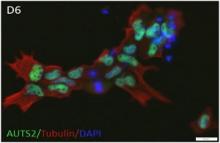- About us
- Research
- Students & Teaching
- Seminars & Events
- Directories
- Booking Rooms & Equipment
- עברית
Home » How do mutations in the same gene lead to diverse brain disorders - Prof. Sagiv Shifman
Mutations in the AUTS2 gene are found in individuals with variable symptoms and diagnoses including intellectual disability, attention-deficit & hyperactivity disorder or autism. Previous research revealed that the more severe cases tend to have mutations located towards the end of the gene.
A new study, led by Dr. Galya Rothkoff and Prof. Sagiv Shifman, has shown that the AUTS2 gene produces two protein forms - a short and a long version, and the precise expression of these protein forms is essential for regulating neurons generation. During differentiation of embryonic stem cells to neurons a shift from the long to the short protein occurs.
The two forms of protein display different molecular functions, including which proteins they bind, how they regulate the activity of other genes, and how they affect the process of differentiation to neurons.
The timing of neuron generation is crucial for determining the size of the brain. This study suggests that microcephaly seen in individuals with mutations in AUTS2 may result from faster differentiation of stem cells to neurons. The study shows that mutations affecting the two forms of the protein lead to a more pronounced cell death during differentiation to neurons. This observation can explain how the location of mutations can affect severity of symptoms, since the two protein forms are affected by mutations in the end of the AUTS2 gene.
